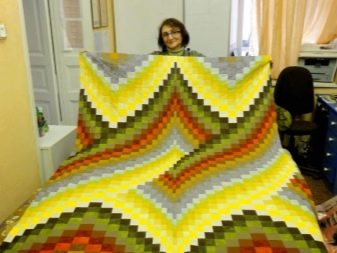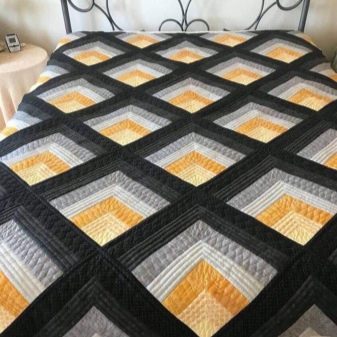Today we will get acquainted with a surprisingly spectacular, but at the same time unconventional patchwork pattern - the bargello. Its principle is to create interesting ornaments by forming stepped lines or bends with a smooth transition of shades.
Products made in patchwork bargello technique, look very difficult but at the same time in the manufacture they are very simple and affordable for sewing even to those who are just taking their first steps in needlework.



Features
According to the description, the bargello is one of the accelerated patchwork techniques in which all canvases are sewn together by strips into one common sleeve, after which they are cut perpendicularly and steamed in some places. As a result, a new tint strip is formed in a variety of combinations - such stripes form a spectacular and vibrant color canvas.

The history of the bargello is rooted in the distant past. Initially, the direction was created as one of the techniques of ancient embroidery.
According to one version, the bargello appeared in Poland, and it was invented by a Hungarian princess named Jadwigawho was the wife of the Polish king. When Jadwiga embroidered the priestly vestments in this unusual technique, everyone found out about her. She depicted the coat of arms of both countries - Poland and Hungary, and it was a real masterpiece, a work of art. Many women liked this way of decorating clothes and household items, and they tried to repeat such embroidery. They were truly overwhelmed by how simple this turned out to be.

Modern needlewomen have borrowed this principle for patchwork. Bargello in this style has retained its essence, that is, the formation of ornamental patterns by compiling zigzag lines with tints of tones. As a result of this decision, things in the style of patchwork-bargello outwardly resemble a gradient or ombre. To achieve this effect, sewing masters shift the strips relative to each other.


Necessary materials
When creating a spectacular patchwork bargello, the most the main thing is to choose the right material. Here, the fantasy of needlewomen is almost unlimited, since any color range can be used in the work. Traditionally, for the sewing of blankets and plaids, several shades are selected in a single gamut, ranging from light to dark. However, if you wish, you can always take contrasting or complementary tones of different colors - there are no strict rules, the colors are combined at the discretion of the craftswoman, while the technique allows the most daring experiments.



In order to sew a blanket, you must prepare:
- pieces of fabric 20-24 shades;
- 2 m of fabric of any dark color for finishing the finished product;
- lining fabric measuring approximately 120x160 cm;
- material for the design of the back of the product.

If you sew for a child or a person suffering from allergies, then the fabric must first be subjected to a full-fledged process of decanting.
To do this, first it is soaked without the addition of detergents, then it is thoroughly rinsed and steamed with an iron or a special device. As a result of such actions, excess dye leaves the fabric, factory impregnation is neutralized, and the smell disappears.

Similar manipulations can be performed when creating an adult product. - in this case, after heat treatment, the fabric will shrink, and you can not worry about the fact that during the first washing your coverlet will change in size or skew.
Ready-made strips marked with numbers are sold in handicraft stores, which greatly facilitates the work of those who are just taking their first steps in the patchwork.

Step by step execution
The essence of the bargello technique is that a stylish ornament comes out of a large number of multi-colored strips of matter to apply certain patterns for their further stitching. The total number of such strips, as well as the tint palette, may vary.

Before mastering the original style, experienced craftswomen advise you to get acquainted with the formation of blocks by the strip-to-strip method, which is one of the simplest in patchwork in principle, it involves connecting several bands sequentially stitched together.
To do this, you need to take cuts of matter and form strips of 5 colors - you can take a variety of shades that will fully correspond to personal preferences and the style of the interior. To create a 30x30 cm block, the strips should be approximately 5x35 cm in size. Progressively, moving down, all the strips should be interconnected with pins on the side that is longer, and then stitch them.


Many novice craftswomen wonder why they need to cleave workpieces. It's simple - only in this way can you reliably fix a section of the canvas so that it does not lead when connected on a typewriter. The pins are fixed in the direction perpendicular to the seam and left until the end of trimming. After each grinding, each seam should be ironed carefully. It can be said that both iron and pins are full and unchanged “participants” in the entire patchwork sewing process cycle. You cannot let go of this rule.

From the finished large piece, four triangles of equal size should be cut. When all four small blocks are completely ready, they should be assembled into a single one according to the principle of “strip to strip”. All blanks are stitched in pairs. To do this, they are placed with their faces towards each other, chipped and sewn in a horizontal line.Then both halves are sewn vertically and stitched from the inside, and then from the front side.

Patchwork-style block strips are ready, from them you can quickly and simply make some interesting little thing for home decor or for children.
And if you take several types of denim, cut into strips, you can make a stylish beach bag. If desired, it can be additionally decorated with applique, beads, cords, zippers or embroidery. Such an accessory will turn out to be very beautiful and convenient, it will be a shame to appear in society with it. After that, you can move on to more overall things, such as bedspreads.


In our master class, we will step by step look at the most primitive, but at the same time very effective scheme. Using our recommendations, even inexperienced craftsmen will be able to master this sewing method in a few hours. For work you will need 20 strips of fabric measuring 6x110 cm - this is taking into account the allowances for the seams. All strips should be of different colors.

- All cooked strips are sewn into one web using the strip-to-strip method, that is, the workpieces are alternately sewn, placing them face to each other along the long side. For convenience, they are pre-chopped with pins. After stitching, the blocks are thoroughly ironed from the inside, all the seams must be ironed on one darker side. Then the workpiece is turned over and ironed the front side.
- The result of all the manipulations the canvas is folded in half with the front side inward in length, stab with pins, and then gently sewn on a sewing machine. Novice craftswomen sometimes encounter the fact that when connecting long strips, the canvas begins to warp. To avoid this, it is better to alternate the stitching direction: for example, sew the first pair from right to left, the second - from left to right, the third - again from right to left, and so on.
- As a result of all the actions you get something like a pipe, it must be cut with sharp scissors into transverse stripes so that their width is 5–7 cm. In total, you should have seven details resembling a ring. Each of them should be cut in such a way as to obtain a multistage print; on subsequent strips, the notch should be located a square lower. From about the fifth lane, you should start the reverse movement up one step.
- The resulting stripes are sewn, pairwise connecting them with the outer sides in one direction. Make sure that all seams formed when joining coincide with the seams of the strip in the neighborhood.
- Upon completion of work all sides of the flap need to be leveled, cut off excess material and iron it thoroughly.
If you connect the four blocks, stacking them in different directions, then you can get a rather original drawing that visually resembles a wave.



Using the simple bargello technique, you can create a truly luxurious patchwork quilt, having gained some experience, you can at any time change the methods of strip arrangement, their parameters and combine different color solutions. The sofa cushions made using this technique are very beautiful.
Try it - you will certainly have a stylish exclusive item.


In the next video, you will learn how to stitch a pillow using the Bargello technique.










